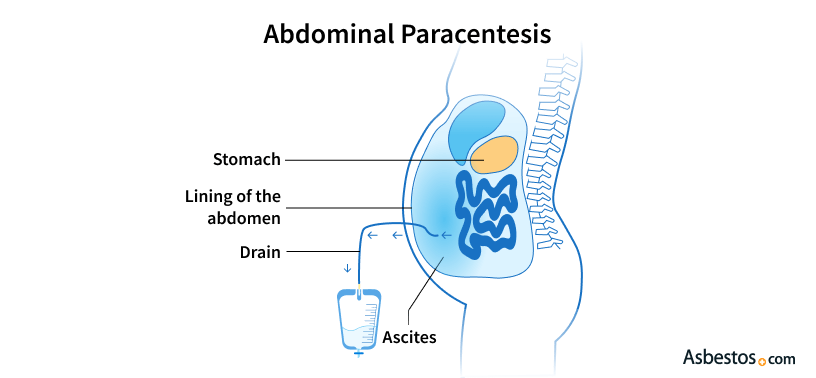Epifanio says his symptoms began when his stomach started swelling and wouldn’t stop. He went to a doctor who told him fluid was accumulating in his peritoneal cavity. The condition is known as peritoneal effusion or ascites. The peritoneal fluid can collect in the abdomen causing swelling or pain. “So we went to a hospital called Memorial West in Florida and from there they told us they weren’t sure,” Epifanio recounted. “So we went to Cleveland Clinic and they diagnosed me with mesothelioma. That was in 2016.”
Paracentesis for Mesothelioma
A paracentesis procedure drains excess fluid (ascites) from the abdomen, a common symptom of peritoneal mesothelioma. Doctors can analyze the fluid to diagnose the cause of the buildup, or they may perform a paracentesis to decompress a swollen abdomen and thereby relieve stomach pain and breathing difficulty.

What Is a Paracentesis?
Paracentesis, also known as an abdominal tap or ascites tap, is a helpful procedure that removes extra fluid from the belly using a hollow needle. This minor surgery provides relief and can improve patients’ comfort.
Inside your abdomen is a lining separating your organs from the abdominal wall. Normally, there is a small amount of fluid between these layers. Fluid in the peritoneal cavity is called ascites or peritoneal effusion if it exceeds an ounce (30 ml). This fluid is known as ascitic fluid.
Quick Facts About Paracentesis
- Helps drain excess fluid from the abdominal lining
- Usually done as an outpatient procedure
- Provides temporary relief from abdominal discomfort
- Less invasive than many other surgical options
When too much ascitic fluid builds up, it can create pressure on your abdominal organs and diaphragm. This buildup may happen because of various reasons, such as infection, injury, liver issues or cancer. Ascites is often seen in cases of peritoneal mesothelioma.
If the goal is to identify the cause of the ascites, a doctor might take as little as 50 mL of fluid for testing. In therapeutic paracentesis, a doctor may remove a liter of fluid or more to provide relief. A study from 2021 suggested that paracentesis can also enhance the clarity of imaging tests, making it a valuable procedure for diagnosis and treatment.
Can a Paracentesis Diagnose Mesothelioma?
Paracentesis can be a helpful procedure for relieving some discomfort caused by peritoneal mesothelioma. However, it’s not the best method for diagnosing this rare cancer. Sometimes, even when cancer is present, the cells found in the ascitic fluid can appear normal. This is why doctors often need to perform a biopsy, which involves taking a small tissue sample for closer examination instead of relying solely on the fluid analysis.
People with peritoneal mesothelioma often experience ascites or peritoneal effusion. This happens because the cancer can lead to a condition called peritoneal carcinomatosis. In this condition, tumors can damage the lining of the abdomen and block the flow of fluids. Additionally, they can weaken the cells in the abdominal wall, which normally help keep proteins and fats from leaking out of blood vessels into the abdomen.
Palliative Paracentesis Benefits and Alternatives
Paracentesis is an easy procedure that allows you to go home the same day. It can help people with cancer feel more comfortable and improve their quality of life, no matter what stage they are in.
However, it’s important to note that paracentesis is a palliative treatment. This means it helps relieve symptoms but does not stop ascites from coming back.
Many patients with peritoneal mesothelioma develop ascites again after the procedure. Because of this, doctors often choose to leave a catheter in place. This allows for continuous drainage of the fluid from the abdomen, which can be more effective.
If the fluid becomes loculated, meaning it collects in smaller areas of the abdomen, a paracentesis may also not work.
On a positive note, surgery combined with heated chemotherapy has changed the landscape of treatment for peritoneal mesothelioma. A review from 2016 found that this method successfully controls ascites in over 90% of patients.
A paracentesis is a safe and effective way of removing unwanted fluid buildup in the abdominal area. Your doctor may suggest this procedure to relieve abdominal pressure, and it can often help to understand why it accumulated. It only takes about a half hour and causes minimal discomfort.

Surgical Consultation for Paracentesis
If you believe paracentesis could be a good choice for your mesothelioma, consider meeting with the surgeon and their team to find out more. During this consultation, you will have the chance to meet the surgeon and their skilled team.
They will review your medical history to help determine if this procedure is right for you. This is also a great time for you to ask questions or share any concerns about paracentesis.
The surgical team will provide all the important information you need to prepare for the procedure and recover afterward. These consultations are vital in ensuring that patients are ready for surgery and feel supported throughout the process. You can have your consultation in person or through a video call, whichever works best for you.

“After reading the guide, I felt more confident about what was ahead.” – Carla F., mesothelioma survivor
Get Your Free GuideThe Paracentesis Procedure
Paracentesis is a helpful outpatient procedure that usually takes about 20 to 30 minutes. To start, doctors often use an ultrasound to see how much fluid has built up in the abdomen.
Once the bladder empties, the patient lies on a bed tilted at a 45-degree angle. This position helps the fluid gather in the lower abdomen. The doctor cleans the area where they will insert the needle and uses a local anesthetic to numb it. After that, they carefully insert a large needle to reach the area where the fluid is located.

As the fluid starts to flow out, it is drained using gravity, a syringe, or a vacuum bottle. Typically, doctors drain only one liter of fluid at a time, at a pace of no more than 500 mL every 10 minutes. This careful approach helps the body balance its fluids and electrolytes. If a lot of fluid is removed, the patient may receive serum albumin to help replace what was lost, keep blood pressure stable, and reduce any risk of shock.
Once the doctor has drained enough fluid, they will cover the insertion site with a sterile dressing. If the procedure needs to be repeated, they may leave a catheter with a flow-control valve and protective dressing in place. Patients can usually go home a few hours later, as long as their blood pressure is normal and they are not feeling dizzy.
Risks and Complications
A paracentesis is a straightforward procedure with very few risks involved. While complications are rare, they can occur. If you have any concerns about the procedure, please talk to your doctor about your specific risks.
Rare Complications of Paracentesis
- Infection
- A persistent leak from the insertion site
- Abdominal wall hematoma (a collection of blood outside a blood vessel)
- Perforation of the small or large intestine, stomach, or bladder
- Hypotension (low blood pressure)
One rare complication noted in a patient with peritoneal mesothelioma was the repeated occurrence of pneumothorax after the procedure. A pneumothorax happens when air builds up in the space around the lungs, which can prevent them from expanding fully. Although this is uncommon, doctors recommend considering it for patients with existing lung issues.
Recommended Reading


